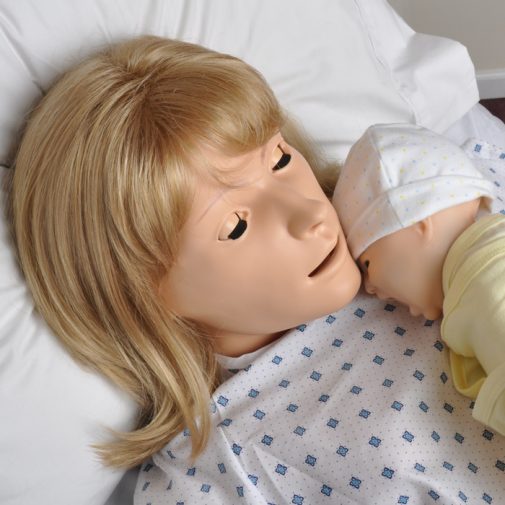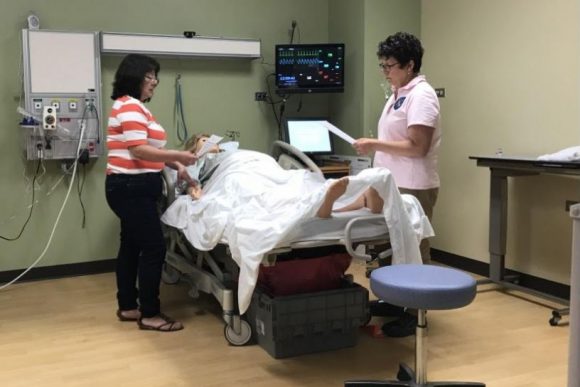Practice makes perfect

Four nurses gather around the bedside as the attending physician reviews the patient’s information.
“Charlotte Thomas, 28-year-old female, was admitted today for induction of labor for pre-eclampsia. The patient has had protracted labor and is progressing and dilating slowly. She started pushing one hour ago with good effort.”
Two nurses tend to Charlotte as her contractions continue. Once she is dilated further, they call her physician, who helps deliver the child.
The child’s face is immediately blue and is not crying. The other two nurses quickly tend to the newborn, as the mother continues to ask how her baby is. As the infant’s heart rate drops, the nurses begin chest compressions.
While this situation is very real, the mother and baby are not. They are high-fidelity mannequins, able to blink, move their arms, turn blue and make bowel sounds. Even their chests rise and fall, and they have cardiac rhythms. 
The group is assembled in Advocate Good Samaritan Hospital’s Simulation Lab. Simulation allows caregivers to practice high-risk, low-frequency situations in a controlled environment. The unit puts on an annual Skills Day in which the nurses come and do a sim and other education requirements. Advocate clinicians participate in a one-hour simulation, followed by a few hours of skills in the classroom. The program is led by simulation education specialist Dikera Gutierrez, who is responsible for continuing education for all disciplines and professions across the Advocate Health Care system. In this particular simulation, Gutierrez created the simulation alongside Olga Lazala, perinatal clinical specialist in the birth center at Good Samaritan Hospital.
The nurses are encouraged to react just as they would in a real situation, using whatever interventions they find appropriate, including giving medications and fluids, throughout the exercise. With focus and determination, they continue working on the baby.
Once the baby begins to cry and reaches a steady heart rate, Charlotte’s heart rate begins to fall. The nurses realize that the resident in the room gave the new mother too much magnesium sulfate, which caused her to stop breathing and heart rate to drop. One nurse begins CPR.
At the conclusion of the simulation, Gutierrez and learners gather around a table to talk through the decisions they made and why they made them. The nurses have the chance to ask questions, make suggestions to one another and talk through any missed opportunities.
“We believe that our nurses are knowledgeable, experienced clinicians who do their very best for the patients we serve each and every day, but continuing their education and challenging them further in simulations such as these are crucial to their success and the safety of our patients,” says Gutierrez. “As caregivers, there is always more we can learn.”
The Simulation Program is part of Advocate Health Care’s strategic plan to improve patient safety and achieve zero events of patient harm by 2020. In the first two quarters of 2017, the Advocate Simulation program has worked with clinical units to identify more than 110 latent safety threats within clinical environments across the system.
Advocate is in the process of building an appropriately sized simulation center at each site. The lab at Advocate Illinois Masonic Medical Center opened last year. Labs at Advocate Good Shepherd Hospital, Advocate South Suburban Hospital and Advocate Christ Medical Center will be open before the end of the year, with more on the way in 2018.
The Simulation Team, in conjunction with site clinical experts, have found 108 Latent Safety Threats in the past six months. These are found by doing simulations and looking for safety concerns in the management of patient condition, systems and processes surrounding the care, and the environment and equipment involved in caring for patients.
Advocate Good Samaritan Gala 2017 beneficiary is nursing education. To learn more or to purchase tickets, visit our website.
Related Posts
Comments
About the Author
Kelsey Sopchyk, health enews contributor, is a media relations coordinator at Advocate Health Care and Aurora Health Care. She earned her BA in journalism and mass communications from the University of Iowa. In her spare time, you can find Kelsey tending to her plant children, trying new sushi restaurants in Chicago and cheering on the Cubs.

















